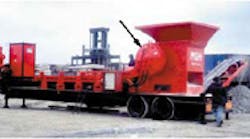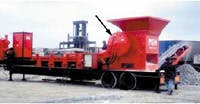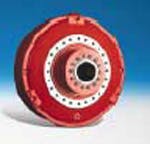Trailer-mounted crushing plant incorporates powerful LSHT hydraulic motor (indicated by arrow above, and shown in inset above) to nibble reinforced concrete slabs, bricks, blocks, and other construction rubble for recycling. Slabs are delivered to the crushing rotor on a conveyor; loose material goes into the hopper.
Denison's P14 axial-piston, closed-circuit pump — part of Gold Cup series — has 14-cir displacement, is rated at 6000 psi.
A major roadblock to successful use of conventional crushing equipment to recycle reinforced concrete slabs is that the steel reinforcement bars get tangled up in high-speed crushers. Engineers at Britain's MGH Recycling Ltd., located near Doncaster in Yorkshire, took a different approach when they developed a slow-speed machine to eliminate this problem. Their design principle incorporates a variable-speed hexagonal rotor, which nibbles the concrete slabs between itself and a V-shaped stationary anvil. The crushed concrete pieces fall away and the bars remain straight, to be fed out for reuse or recycling. (This versatile unit also can process general rubble, bricks, block, and concrete that has no reinforcement bars.) As another operational plus, nibbling does not produce the clouds of dust and fines that surround other crushing techniques.
After troubles with a gearbox combination on their prototype machine, MGH designers turned to a hydraulic motor to drive the rotor. Their choice: a Marathon Series MB 800-C LSHT motor from Häglunds Drives Ltd., the British operation of Sweden's Häglunds Drives AB. This motor incorporates a radial-piston and cam-ring design. Its displacement is 3066 in.3/rev; its maximum pressure rating is 5000 psi; and it generates 40,680 lb-ft of torque per 1000 psi. Maximum speed is 25 rpm, and the motor weighs 5688 lb.
The crusher's otor consists of a series of hexagonal discs joined together. Its shaft is shrink-fitted into the rotating hollow shaft of the Häglunds motor. (The torque-arm mounted motor housing remains stationary.) Concrete slabs are fed horizontally over the anvil, while the rotor passes through it at a controlled maximum speed of 7 rpm. When the rotor crushes the material around the wire, the broken concrete drops onto an outfeed conveyor that carries it out of the machine. The wire travels straight through — free of concrete. (The infeed conveyor runs slightly slower speed the rotor so material the next point of rotor contact occurs.)
The portable MGH machine rides on a 40-ft trailer. A 275-hp Caterpillar diesel engine drives the main close-coupled pump — a Denison Hydraulics Model P14S — which supplies the Marathon motor for the nibbling function. A tandem gear pump mounted on the main pump's rear flange powers the infeed and outfeed conveyors and auxiliary functions.
Häglunds also provided the control system with a closed-loop hydraulic circuit to run the rotor at variable speed in both forward and reverse. The operator starts the Caterpillar diesel manually and then activates the main pump. The control-mode can be manual or automatic. The stainless-steel tank unit with instruments — to monitor pressures, temperatures, oil levels, and filter conditions — is located near the main pump. The control panel and valve stations are positioned that operators have a view of machine functions.
Among safety features is an arrangement to automatically stop the infeed conveyor and put the rotor into reverse if it jams. In addition, a pull cord is fitted around the machine for emergency stopping. In the event of a jam or shutdown, a klaxon and flashing light signal the condition to the operating personnel. Because access to the crushing chamber is physically limited, injuries to operators are virtually impossible.



